 This is the second of three blogs looking at high inflation and its implications. Here we look at changes in the housing market and its effects on households. Another way of analysing the financial importance of the housing and mortgage markets is through the balance sheets and associated flow accounts of the household sector.
This is the second of three blogs looking at high inflation and its implications. Here we look at changes in the housing market and its effects on households. Another way of analysing the financial importance of the housing and mortgage markets is through the balance sheets and associated flow accounts of the household sector.
We used the concept of balance sheets in our blog Bank failures and the importance of balance sheets. In the blog we referred to the balance-sheet effects from interest rate hikes on the financial well-being of financial institutions.
The analysis is analogous for households. Again, we can identify two general effects: rising borrowing and debt-servicing costs, and easing asset prices.
The following table shows the summary balance sheet of the UK household sector in 1995 and 2021.
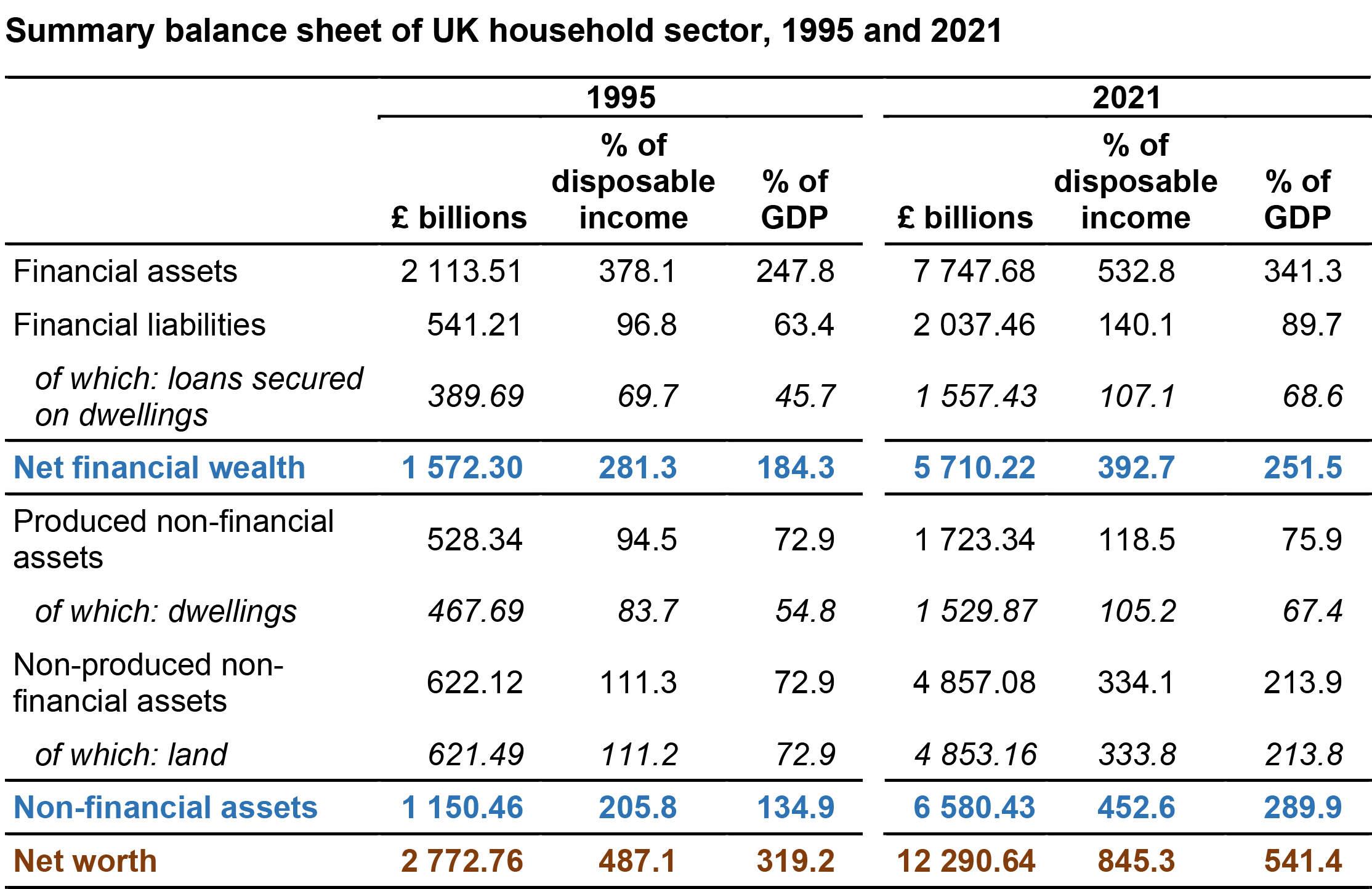
Source: National balance sheet estimates for the UK: 1995 to 2021 (January 2023) and series RPHA, ONS
The total value of the sector’s net wealth (or ‘worth’) is the sum of its net financial wealth and its non-financial assets. The former is affected by the value of the stock of outstanding mortgages, which we can see from row 3 in the table (‘loans secured on dwellings’) has increased from £390 billion in 1995 to £1.56 trillion in 2021. This is equivalent to an increase from 70 to 107 per cent of the sector’s annual disposable income. This increase helps to understand the sensitivity of the sector’s financial position to interest rate increases and the sizeable cash flow effects. These effects then have implications for the sector’s spending.
 Housing is also an important asset on household balance sheets. The price of housing reflects both the value of dwellings and the land on which they sit, and these are recorded separately on the balance sheets. Their combined balance sheet value increased from £1.09 trillion (£467.69bn + £621.49bn) in 1995 to £6.38 trillion (£1529.87bn + £4853.16bn) in 2021 or from 128% of GDP to 281%.
Housing is also an important asset on household balance sheets. The price of housing reflects both the value of dwellings and the land on which they sit, and these are recorded separately on the balance sheets. Their combined balance sheet value increased from £1.09 trillion (£467.69bn + £621.49bn) in 1995 to £6.38 trillion (£1529.87bn + £4853.16bn) in 2021 or from 128% of GDP to 281%.
The era of low inflation and low interest rates that had characterised the previous two decades or so had helped to boost house price growth and thus the value of non-financial assets on the balance sheets. In turn, this had helped to boost net worth, which increased from £2.78 trillion in 1995 to £12.29 trillion in 2021 or from 319% of GDP to 541%.
Higher interest rates and wealth
 The advent of higher interest rates was expected not only to impact on the debt servicing costs of households but the value of assets, including, in the context of this blog, housing. As Chart 3 in the previous blog helped to show, higher interest rates and higher mortgage repayments contributed to an easing of house price growth as housing demand eased. On the other hand, the impact on mortgaged landlords helped fuel the growth of rental prices as they passed on their increased mortgage repayment costs to tenants.
The advent of higher interest rates was expected not only to impact on the debt servicing costs of households but the value of assets, including, in the context of this blog, housing. As Chart 3 in the previous blog helped to show, higher interest rates and higher mortgage repayments contributed to an easing of house price growth as housing demand eased. On the other hand, the impact on mortgaged landlords helped fuel the growth of rental prices as they passed on their increased mortgage repayment costs to tenants.
Higher interest rates not only affect the value of housing but financial assets such as corporate and government bonds whose prices are inversely related to interest rates. Research published by the Resolution Foundation in July 2023 estimates that these effects are likely to have contributed to a fall in the household wealth from early 2021 to early 2023 by as much as £2.1 trillion.
The important point here is that further downward pressure on asset prices is expected as they adjust to higher interest rates. This and the impact of higher debt servicing costs will therefore continue to impact adversely on general financial well-being with negative implications for the wider macroeconomic environment.
Articles
- The Mortgage Crunch
Resolution Foundation, Simon Pittaway (17/6/23)
- Peaked Interest?
Resolution Foundation, Molly Broome, Ian Mulheirn and Simon Pittaway (17/7/23)
- UK inflation to fall to lowest level since March 2022 but Bank of England still tipped to hike interest rates
City A.M., Jack Barnett (17/7/23)
- Mortgage payments set to jump by £500 for one million households
BBC News, Tom Espiner (13/7/23)
- Interest rates: Big rise less likely after inflation surprise
BBC News, Daniel Thomas, Faisal Islam & Dharshini David (19/7/23)
- Rising Mortgage Costs. What Can Be Done?
NIESR blog, Max Mosley and Adrian Pabst (17/7/23)
- UK interest rates forecast to rise less sharply after inflation falls to 7.9%
The Guardian, Richard Partington (19/7/23)
- Mortgage costs: More Scots falling behind on repayments
Herald Scotland, Kristy Dorsey (18/7/23)
Report
Data
Questions
- What possible indicators could be used to assess the affordability of residential house prices?
- What do you understand by the concept of the monetary policy transmission mechanism? How do the housing and mortgage markets relate to this concept?
- What factors might affect the proportion of people taking out fixed-rate mortgages rather than variable-rate mortgages?
- What is captured by the concept of net worth? Discuss how the housing and mortgage markets affect the household sector’s net worth.
- What are cash-flow effects? How do rising interest rates effect savers and borrowers?
- How might wealth effects from rising interest rates impact younger and older people differently?
- Discuss the ways by which house price changes could affect household consumption.
 March 2023 saw the failure of Silicon Valley Bank (SVB), a regional US bank based in California that focused on financial services for the technology sector. It also saw the forced purchase of global-banking giant, Credit Suisse, by rival Swiss bank, UBS. These events fuelled concerns over the banking sector’s financial well-being, with fears for other financial institutions and the wider economy.
March 2023 saw the failure of Silicon Valley Bank (SVB), a regional US bank based in California that focused on financial services for the technology sector. It also saw the forced purchase of global-banking giant, Credit Suisse, by rival Swiss bank, UBS. These events fuelled concerns over the banking sector’s financial well-being, with fears for other financial institutions and the wider economy.
Yet it is not the only sector where concerns abound over financial well-being. The cost-of-living crisis, the hike in interest rates and the economic slowdown continue to have an adverse impact on the finances of households and businesses. Furthermore, many governments face difficult fiscal choices in light of the effects of recent economic shocks, such as COVID and the Russian invasion of Ukraine, on the public finances.
Balance sheets and flow accounts
When thinking about the financial well-being of people, business and governments it is now commonplace for economists to reference balance sheets. This may seem strange to some since it is easy to think of balance sheets as the domain of accountants or those working in finance. Yet balance sheets, and the various accounts that lie behind them, are essential in analysing financial well-being and, therefore, in helping to understand economic behaviour and outcomes. Hence, it is important for economists to embrace them too.
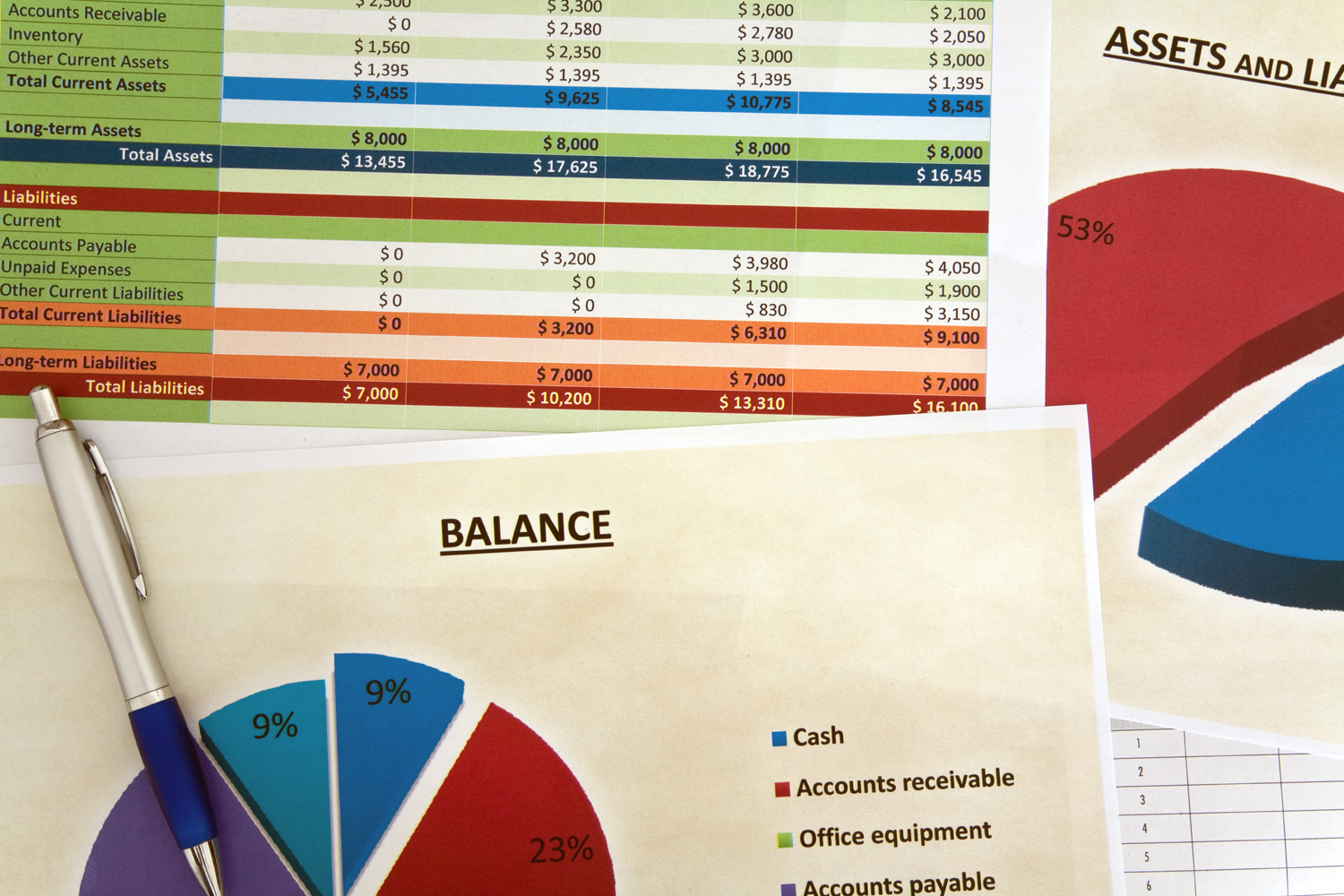 A balance sheet is a record of stocks of assets and liabilities of individuals or organisations. Behind these stocks are accounts capturing flows, including income, expenditure, saving and borrowing. There are three types of flow accounts: income, financial and capital. Together, the balance sheets and flow accounts provide important insights into the overall financial position of individuals or organisations as well as the factors contributing to changes in their financial well-being.
A balance sheet is a record of stocks of assets and liabilities of individuals or organisations. Behind these stocks are accounts capturing flows, including income, expenditure, saving and borrowing. There are three types of flow accounts: income, financial and capital. Together, the balance sheets and flow accounts provide important insights into the overall financial position of individuals or organisations as well as the factors contributing to changes in their financial well-being.
The stock value of a sector’s or country’s non-financial assets and its net financial worth (i.e. the balance of financial assets over liabilities) is referred to as its net worth. Non-financial assets include produced assets, such as dwellings and other buildings, machinery and computer software, and non-produced assets, largely land.
An increase in the net worth of the sectors or the whole country implies greater financial well-being, while a decrease implies greater financial stress. Yet a deeper understanding of financial well-being also requires an analysis of the composition of the balance sheets as well as their potential vulnerabilities from shocks, such as interest rate rises, falling asset prices or borrowing constraints.
UK net worth
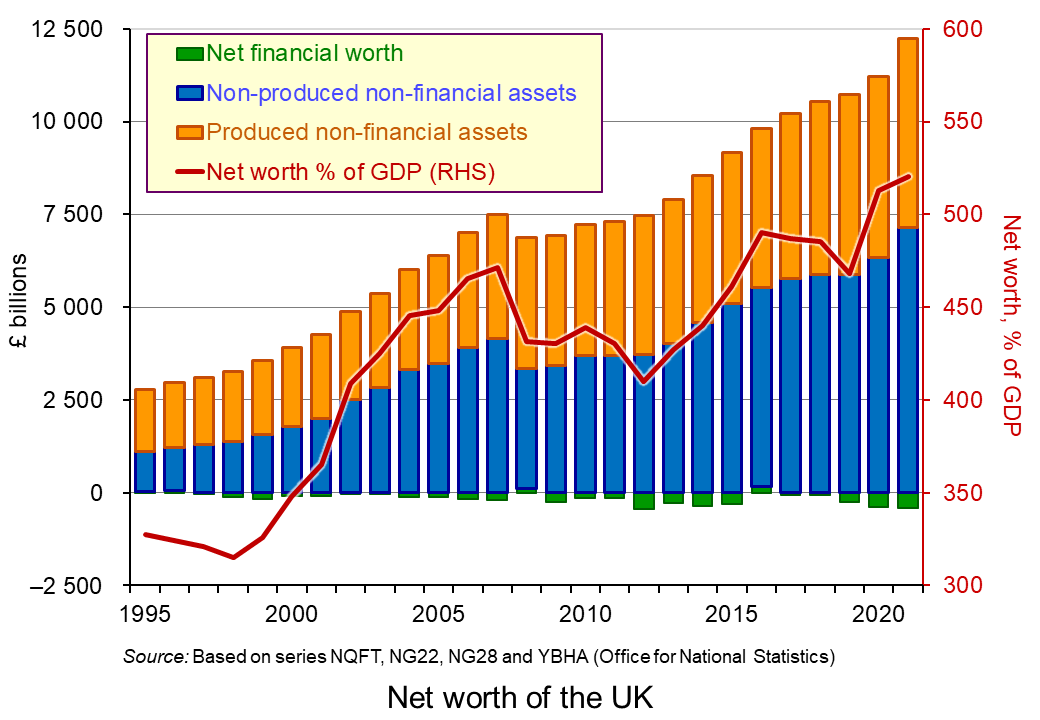 The chart shows the UK’s stock of net worth since 1995, alongside its value relative to annual national income (GDP) (click here for a PowerPoint). In 2021, the net worth of the UK was £11.8 trillion, equivalent to 5.2 times the country’s annual GDP. This marked an increase of £1.0 trillion or 9 per cent over 2020. This was driven largely by an increase in land values (non-produced non-financial assets).
The chart shows the UK’s stock of net worth since 1995, alongside its value relative to annual national income (GDP) (click here for a PowerPoint). In 2021, the net worth of the UK was £11.8 trillion, equivalent to 5.2 times the country’s annual GDP. This marked an increase of £1.0 trillion or 9 per cent over 2020. This was driven largely by an increase in land values (non-produced non-financial assets).
In contrast, the stock of net worth fell in both 2008 and 2009 at the height of the financial crisis and the ensuing economic slowdown, which contributed to the country’s net worth falling by over 8 per cent.
The chart shows that net financial assets continue to make a negative contribution to the country’s net worth. In 2021 financial liabilities exceeded financial assets by the equivalent of 19 per cent of annual national income.
Non-financial corporations and the public sector together had financial liabilities in excess of financial assets of £3.4 trillion and £2.5 trillion respectively. However, once non-financial assets are accounted for, non-financial corporations had a positive net worth of £607 billion, although their value was not sufficient to prevent the public sector having a negative net worth of £1.2 trillion. Meanwhile, households had a positive net worth of £11.4 trillion and financial corporations a negative net worth of £4.9 billion.
Vulnerabilities and the balance sheets
The collapse of Silicon Valley Bank (SVB) resulted from balance sheet distress. Some argue that this distress can be attributed to a mismanagement of the bank’s liquidity position, which saw the bank use the surge in funds, on the back of buoyant activity among technology companies, to purchase long-dated bonds while, at the same time, reducing the share of assets held in cash. However, as the growth of the technology sector slowed as pandemic restrictions eased and, crucially, as central banks, including the Federal Reserve, began raising rates, the value of these long-dated bonds fell. This is because there is a negative relationship between interest rates and bond prices. Bonds pay a fixed rate of interest and so as other interest rates rise, bonds become less attractive to savers, pushing down their price. As depositors withdrew funds, Silicon Valley Bank found itself increasingly trying to generate liquidity from assets whose value was falling.
A major problem with balance sheet distress is contagion. This can occur, in part, because of what is known as ‘counterparty risk’. This simply refers to the idea that one party’s well-being is tied directly to that of another. However, the effects on economies from counterparty risks can be amplified by their impact on general credit conditions, confidence and uncertainty. This helps to explain why the US government stepped in quickly to guarantee SVB deposits.
There is, however, a ‘moral hazard’ problem here: if central banks are always prepared to step in, it can signal to banks that they are too big to fail and disincentivise them for adopting appropriate risk management strategies in the first place.
Subsequently, First Citizens Bank acquired the commercial banking business of SVB, while its UK subsidiary was acquired by HSBC for £1.
Interest rates and financial well-being
In light of the failures of SVB and Credit Suisse, the raising of interest rates by inflation-targeting central banks has raised concerns about the liquidity and liabilities positions of banks and non-bank financial institutions, such as hedge funds, insurers and pension funds. As we have seen, higher interest rates push down the value of bonds, which form a major part of banks’ balance sheets. The problem for central banks is that, if this forced them to make large-scale injections of liquidity by buying bonds (quantitative easing), it would make the fight against inflation more difficult. Quantitative easing is the opposite of tightening monetary policy and thus credit conditions, which are seen as necessary to control inflation.
 Yet the raising of interest rates has implications for the financial well-being of other sectors too since they also are affected by the effects on asset values and debt-servicing costs. For example, raising interest rates has a severe impact on the cashflow of UK homeowners with large variable-rate mortgages. This can substantially affect their spending. The UK has a high proportion of homeowners on variable-rate mortgages or fairly short-term fixed-rate mortgages. Also for a large number of households their mortgages are high relative to their incomes.
Yet the raising of interest rates has implications for the financial well-being of other sectors too since they also are affected by the effects on asset values and debt-servicing costs. For example, raising interest rates has a severe impact on the cashflow of UK homeowners with large variable-rate mortgages. This can substantially affect their spending. The UK has a high proportion of homeowners on variable-rate mortgages or fairly short-term fixed-rate mortgages. Also for a large number of households their mortgages are high relative to their incomes.
In short, falling asset values and increasing debt-servicing costs from rising interest rates in response to rising inflation tends to dampen spending in the economy. The effects will be larger the more burdened with debt people and businesses are, and the less liquidity they have to access. This has the potential to lead to a financial consolidation in order to restore the well-being of balance sheets. This involves cutting borrowing and spending.
Such a consolidation could be exacerbated if financial institutions become distressed and if it were to result in even larger numbers of people and businesses facing greater restrictions in accessing credit. These balance sheet pressures will continue to weigh on the policy responses of central banks as they attempt to navigate economies out of the current inflationary pressures.
Articles
Questions
- What is recorded on a balance sheet? Explain with reference to the household sector.
- What is meant by net worth? Does an increase in net worth mean that an individual’s or sector’s financial well-being has increased?
- What is meant by ‘liquidity-constrained’ individuals or businesses? What factors might explain how liquidity constraints arise?
- It is sometimes argued that there is a predator-prey relationship between income and debt. How could such a relationship arise and what is its importance for the economy?
- Why might a deterioration of a country’s balance sheets have both national and international consequences?
- Explain the possible trade-offs facing central banks when responding to inflationary pressures.
 The UK is a productivity laggard. Compared to many developed countries over the recent past it has experienced weaker growth in output per worker and output per hour worked. This is detrimental to our longer-term well-being and to peoples’ living standards. An important contributory factor has been the weakness of growth in (non-financial) capital per worker. Recent ONS figures show that UK experienced a decline in capital per worker from 2012 to 2015, which was only ended in 2016.
The UK is a productivity laggard. Compared to many developed countries over the recent past it has experienced weaker growth in output per worker and output per hour worked. This is detrimental to our longer-term well-being and to peoples’ living standards. An important contributory factor has been the weakness of growth in (non-financial) capital per worker. Recent ONS figures show that UK experienced a decline in capital per worker from 2012 to 2015, which was only ended in 2016.
Non-financial capital assets (also known as fixed assets) are defined as already-produced, durable goods or any non-financial asset used in the production of goods or services. This includes items such as dwellings, buildings, ICT, machinery and transport equipment.
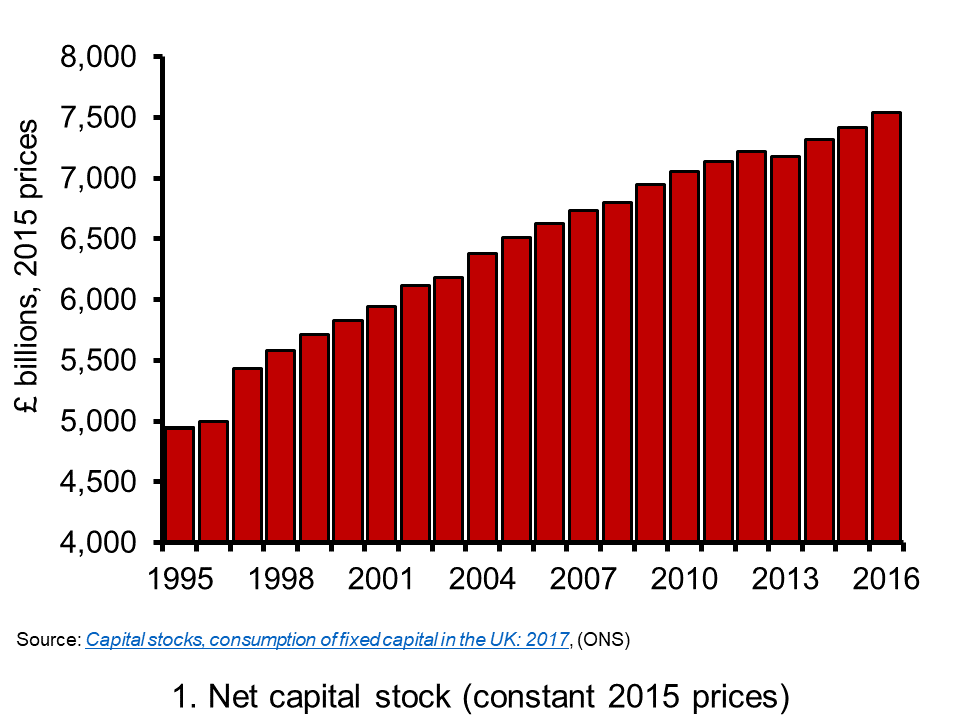 Chart 1 shows the value of net capital assets in the UK since 1995. ‘Net’ figures account for the depreciation of assets and so reflect the market value of the capital stock. At the end of 2016 the net capital stock was estimated at £7.54 trillion (at 2015 prices) compared to £4.94 trillion (at 2015 prices) in 1995, an increase of 53 per cent or about 2.4 per cent per year.
Chart 1 shows the value of net capital assets in the UK since 1995. ‘Net’ figures account for the depreciation of assets and so reflect the market value of the capital stock. At the end of 2016 the net capital stock was estimated at £7.54 trillion (at 2015 prices) compared to £4.94 trillion (at 2015 prices) in 1995, an increase of 53 per cent or about 2.4 per cent per year.
However, as the chart shows, the rate of growth slowed markedly following the financial crisis of the late 2000s, averaging a mere 0.8 per cent per year since 2010. (Click here for a Powerpoint of the chart).
Capital intensity can be measured by the amount of capital per employee. Capital intensity is important because the growth in net capital per employee impacts on productivity. Its growth has an impact on the current effectiveness of capital and labour in production and on the future growth in potential output per employee.
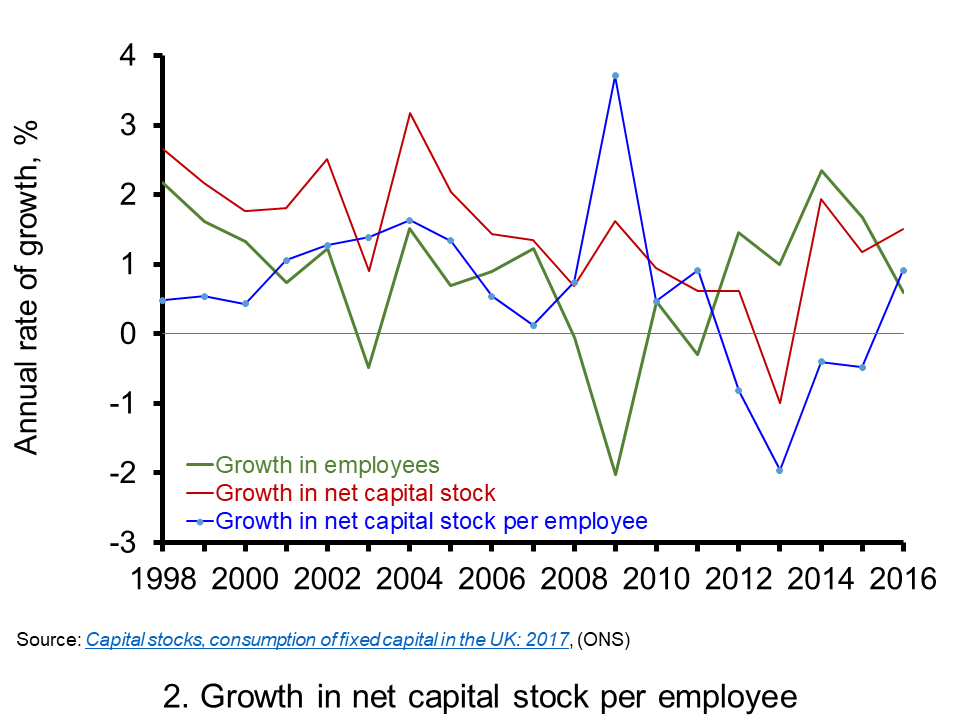 Chart 2 shows that, following the financial crisis, falling employment levels temporarily boosted the growth in net capital per employee. Then, as employment levels recovered and began growing again, the weakness in investment meant that net capital per employee began to fall.
Chart 2 shows that, following the financial crisis, falling employment levels temporarily boosted the growth in net capital per employee. Then, as employment levels recovered and began growing again, the weakness in investment meant that net capital per employee began to fall.
In 2016, as employment growth slowed, the now stronger flows of investment meant that, for the first time since 2011, net capital per employee was finally rising again. (Click here for a PowerPoint of the chart).
The persistent weakness experienced by UK in the growth of capital intensity in the 2010s is a drag on productivity and on supply-side growth. The weakness of UK productivity growth looks like remaining for some time one of the biggest economic challenges facing policymakers. Productivity needs its capital.
Articles
UK business investment on ice until more Brexit progress, warns BCC The Guardian, Richard Partington (11/12/17)
Budget 2017: Can Digital Plug The UK’s Productivity Gap? Hufttington Post, William Newton (27/11/17)
UK productivity estimates must be ‘significantly’ lowered, admits OBR The Guardian, Richard Partington and Phillip Inman (13/12/17)
UK productivity sees further fall BBC News (6/10/17)
Data
Capital stocks, consumption of fixed capital in the UK: 2017 ONS
Questions
- How might we measure productivity?
- Compose a list of items that are examples of non-financial (or fixed) capital.
- How can the growth of non-financial (or fixed) capital affect productivity?
- What is meant by capital intensity? Why is this concept important for long-term growth?
- What factors might affect the rate of capital accumulation? Are there interventions that governments can make to impact on the rate of capital accumulation?
- Discuss the possible reasons why the UK has become a productivity laggard.
In Gloomy prospects for UK consumer spending in 2012? we talked about how consumer spending can be affected by the financial position of households. Figures from United Kingdom National Accounts – Blue Book 2011 (see Tables 6.1.9 and 10.10) give the latest complete set of balance sheets for the UK household sector. The figures are for 2010 and in this blog we provide a brief overview of what these figures reveal.
In effect, there are two main balance sheets of interest for households (and non-profit institutions serving households (NPISHs), i.e. charities and voluntary organisations). The first details their net financial wealth and the second their physical wealth, also known as their non-financial wealth. We begin with net financial wealth. This is found by subtracting financial liabilities (debt) from financial assets. The household sector in 2010 had financial liabilities of £1.54 trillion equivalent to 1.6 times its disposable income for the year or 1.1 times the nation’s Gross Domestic Product. Of these liabilities, £1.2 trillion was mortgage debt, i.e. loans secured against property. On the other hand, the sector had financial assets of £4.3 trillion equivalent to 4.4 times its disposable income in 2010 or 3 times GDP. Of these financial assets, the value in pension funds and life assurance was £2.27 trillion.
The net financial wealth of households and NPISHs in 2010 was £2.8 trillion, 2.9 times the sector’s disposable income for the year or 1.9 times GDP. To this we need to add physical wealth of £4.9 trillion, a massive 5 times the sector’s disposable income or 3.3 times the nation’s GDP. The majority of this is residential buildings the value of which were put at £4 billion for 2010. This demonstrates the significance of housing to the UK household sector balance sheet.
If we now add physical wealth to net financial wealth, we find that in 2010 the household and NPISH sector had a net worth of £7.7 trillion. To put this in context, it is equivalent to 7.8 times the disposable income it earned in 2010 and 5.3 times the UK’s Gross Domestic Product. While these are enormous figures it is worth noting that in 2007 the sector’s net worth was £7.4 trillion, equivalent to 8.5 times annual disposable income.
A trawl through the figures clearly shows the impact of the financial crisis on the sector’s net worth. From £7.4 trillion in 2007, net worth fell in 2008 to £6.6 trillion or 7.2 times annual disposable income. However, 2009 and 2010 did see the households’ net worth increase again – including relative to its disposable income. This has been the result of its net financial wealth increasing. Net financial wealth in 2010 was 9.8 per cent higher than in 2007. However, the depressed housing market has continued to adversely impact on the sector’s net worth. Physical wealth in 2010 was 0.7 per cent lower than in 2007.
Of course, while these empirical observations are undoubtedly interesting, the key question for debate is how these patterns affect household behaviour. Of particular importance, is how changes in both the household sector’s total net worth and the components making up the total will translate into changes in consumer spending. Economists are increasingly recognising that in understanding consumer spending patterns we need to gain a deeper understanding of the impact of the balance sheets on consumer spending. It is quite likely that many retailers when forming their plans for the year ahead will be analysing the potential impact of household finances on spending behaviour. Developing strategies to respond to the state of the household balance sheets may be crucial to their success.
Data
United Kingdom National Accounts – Blue Book 2011 (datasets) Office for National Statistics (see Tables 6.1.9 and 10.10)
Articles
Debt levels head towards £30,000 for every adult Mirror, Tricia Phillips (2/12/11)
40% risk getting further in debt this Christmas Independent, Simon Read (3/12/11)
Uk’s debts ‘biggest in the world’ BBC News, Robert Peston (21/11/11) (This article looks at debt across all sectors, including corporate and government debt too)
Drowning in debt: Warning over 4,000% interest rates as 3.5m people say they will be forced to take out ‘payday’ loans in the next 6 months Daily Mail, Emily Allen (7/12/11)
UK households wealthier than Germany’s says UBS Telegraph, Jamie Dunkley (9/12/11)
Questions
- In the context of the household balance sheets, explain the difference between the concepts of stocks and flows.
- Illustrate with examples your understanding of what is meant by secured and unsecured debt. What factors are likely to affect the growth from one period to another in the stocks of secured and unsecured debt outstanding?
- Draw up a list of possible factors that could affect the value of the household sector’s net financial wealth. Now repeat the exercise for non-financial wealth.
- Draw up a list of ways in which you think changes to the values of items on the household balance sheets could affect consumer spending. After drawing up this list consider their significance in 2012.
- What sort of items would be included in the balance sheets of firms and of government?
 This is the second of three blogs looking at high inflation and its implications. Here we look at changes in the housing market and its effects on households. Another way of analysing the financial importance of the housing and mortgage markets is through the balance sheets and associated flow accounts of the household sector.
This is the second of three blogs looking at high inflation and its implications. Here we look at changes in the housing market and its effects on households. Another way of analysing the financial importance of the housing and mortgage markets is through the balance sheets and associated flow accounts of the household sector. 
 Housing is also an important asset on household balance sheets. The price of housing reflects both the value of dwellings and the land on which they sit, and these are recorded separately on the balance sheets. Their combined balance sheet value increased from £1.09 trillion (£467.69bn + £621.49bn) in 1995 to £6.38 trillion (£1529.87bn + £4853.16bn) in 2021 or from 128% of GDP to 281%.
Housing is also an important asset on household balance sheets. The price of housing reflects both the value of dwellings and the land on which they sit, and these are recorded separately on the balance sheets. Their combined balance sheet value increased from £1.09 trillion (£467.69bn + £621.49bn) in 1995 to £6.38 trillion (£1529.87bn + £4853.16bn) in 2021 or from 128% of GDP to 281%. The advent of higher interest rates was expected not only to impact on the debt servicing costs of households but the value of assets, including, in the context of this blog, housing. As Chart 3 in the previous blog helped to show, higher interest rates and higher mortgage repayments contributed to an easing of house price growth as housing demand eased. On the other hand, the impact on mortgaged landlords helped fuel the growth of rental prices as they passed on their increased mortgage repayment costs to tenants.
The advent of higher interest rates was expected not only to impact on the debt servicing costs of households but the value of assets, including, in the context of this blog, housing. As Chart 3 in the previous blog helped to show, higher interest rates and higher mortgage repayments contributed to an easing of house price growth as housing demand eased. On the other hand, the impact on mortgaged landlords helped fuel the growth of rental prices as they passed on their increased mortgage repayment costs to tenants. March 2023 saw the failure of Silicon Valley Bank (SVB), a regional US bank based in California that focused on financial services for the technology sector. It also saw the forced purchase of global-banking giant, Credit Suisse, by rival Swiss bank, UBS. These events fuelled concerns over the banking sector’s financial well-being, with fears for other financial institutions and the wider economy.
March 2023 saw the failure of Silicon Valley Bank (SVB), a regional US bank based in California that focused on financial services for the technology sector. It also saw the forced purchase of global-banking giant, Credit Suisse, by rival Swiss bank, UBS. These events fuelled concerns over the banking sector’s financial well-being, with fears for other financial institutions and the wider economy. A balance sheet is a record of stocks of assets and liabilities of individuals or organisations. Behind these stocks are accounts capturing flows, including income, expenditure, saving and borrowing. There are three types of flow accounts: income, financial and capital. Together, the balance sheets and flow accounts provide important insights into the overall financial position of individuals or organisations as well as the factors contributing to changes in their financial well-being.
A balance sheet is a record of stocks of assets and liabilities of individuals or organisations. Behind these stocks are accounts capturing flows, including income, expenditure, saving and borrowing. There are three types of flow accounts: income, financial and capital. Together, the balance sheets and flow accounts provide important insights into the overall financial position of individuals or organisations as well as the factors contributing to changes in their financial well-being. The chart shows the UK’s stock of net worth since 1995, alongside its value relative to annual national income (GDP) (click
The chart shows the UK’s stock of net worth since 1995, alongside its value relative to annual national income (GDP) (click 

